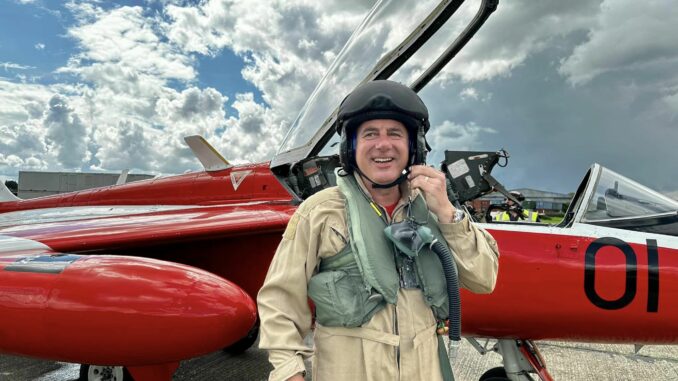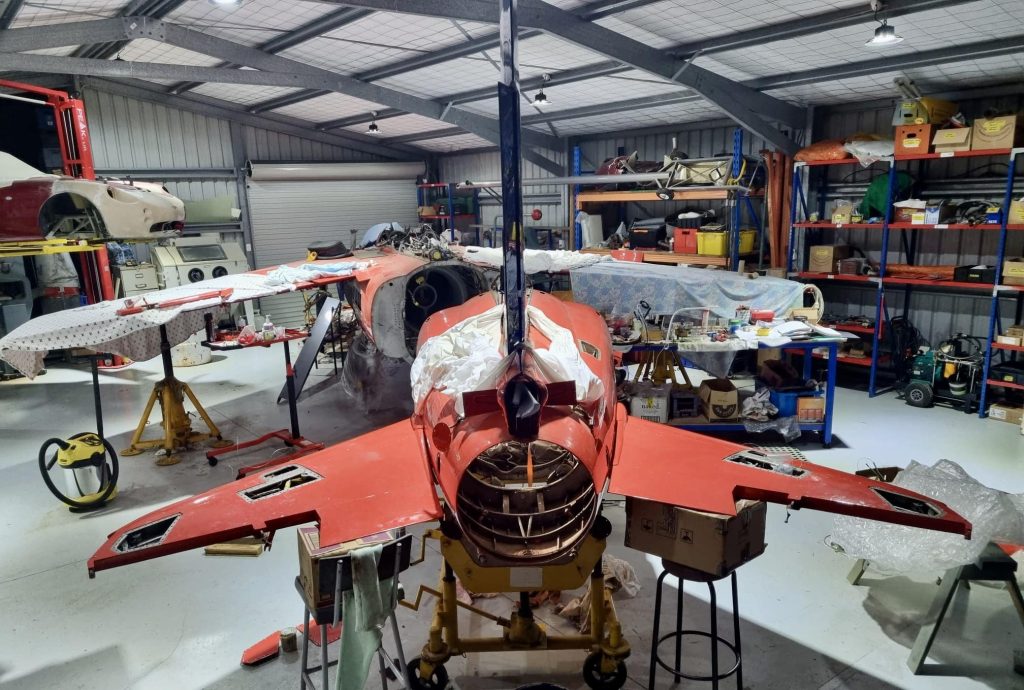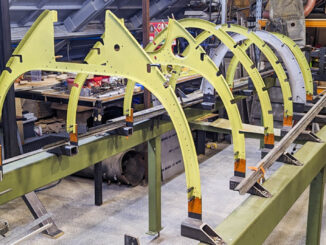
As reported by Vintage Aviation News earlier this year, Folland Gnat XR987 — now with the New Zealand civil registration ZK-RAJ, for “Red Arrows Jet” — is being returned to airworthiness at the workshops of Aero Restoration (Aero R) south of Auckland in the North Island for owner Matt Wilcock.
Matt, now an Airbus captain with Cathay Pacific, started his aviation career by joining #12 SQN Royal Canadian Air Cadets in Edmonton, Alberta when he turned 12 in 1979. “I spent nearly 7 years with the cadets gaining my glider pilots license in 1984 and my PPL in 1985, both on scholarships with the Air Cadets. From there I spent time flying with the glider familiarization team as we took various local cadet squadrons as they were rostered a day to come out to us and each cadet was taken flying while we flew the gliders and the tow planes and ran the operation.”

After moving home to New Zealand Matt completed my CPL and instrument training and spent time flying for a skydiving operation before moving to Mountain Air flying Piper Aztecs and Britten-Norman Islanders. “After I left there I worked a summer for Great Barrier flying mostly the same types including the Trislander. I then was hired as a First Officer by Air Nelson flying the Saab 340 and then, through some contacts, got a job flying CRJ-200s and CRJ-700s out of Hong Kong. I joined Cathay Pacific as a Second Officer on the A340 and 6 months later also on the A330 and to where I am today in my current role as a Check and Training Captain on the Airbus A350 and A330.”
He had been involved in another syndicate but after the airplane was sold Matt was on the lookout for “something unique, fast, two seats at least and that would be of interest at airshows etc. I have always admired the Gnat: my parents gave me a book which had the Red Arrows when they flew the Gnat on the cover and it always stuck with me. At some point around 2016 I was looking through the Trade-A-Plane website and I saw a Gnat for sale. I started to look into it a lot more and found that it met a lot of what I was looking for and on the plus side, the fuel burn and operating costs were not astronomical. All up, it looked like I could afford it.
“Around the time I was starting to seriously consider buying it my friend, the late David Corrick, called me and we had a long conversation about airplanes and I mentioned to him this Gnat. He was immediately interested so we spoke a number of times about it and David started reaching out to contacts to find out more about Gnats and what we would need to know. In 2019 I flew to LAX and drove down to an airport very close to the Mexican border to see the original Gnat I had seen for sale.”
“In the meantime XR987 had just become available for sale so, after visiting the other Gnat, I flew to Florida for a day to see XR987. It was in great condition and one of the biggest upsides was the huge amount of spares it came with, literally a container full of spares. In July 2019 we had made contact with an engineer, ex-RAF and had worked on Gnats and was still active in aircraft engineering in Australia and we flew him to Florida to give us a pre-purchase inspection. That went well, although there were the usual paperwork issues in terms of what had been done to the airplane as in the USA an experimental aircraft needs no records kept of changes that have been made.”

“Mostly XR987 had been rewired with new electrical cabling and upgraded cockpit instruments to a slightly more modern standard. I’m not sure when the last time was that she flew, I believe it has been a little over 20 years or so. The engine had been overhauled and flown for a few hours then she was put in storage, which is good news on the engine front. We eventually packed up the Gnat and after struggles with the Defense Directorate of Trade Controls, essentially the Congressional arm of the military to get an export clearance, we eventually solved that puzzle and then of course Covid arrived. We managed to get XR987 to the Port of Tauranga in January of 2021, which was a moment I’ll never forget as I thought we might never get her to NZ.”

“The Gnat was in Tauranga for about six months and spent some of that time on display with Classic Flyers however ultimately we decided to move her up to our engineers shop south of Ardmore at Aero R. Sadly, in November of 2021 David passed away quite suddenly. This put a halt on proceedings until I could decide what the future of the project looked like. I eventually pressed ahead after some great discussions with Paul [Levitt], the engineer and owner of Aero R.”

Aero R has had two full time engineers working on the Gnat amongst with other work, chiefly on another British Cold War jet in the shape of Paul Stent’s NF.11 Meteor project which is also being returned to airworthiness by the team. “There are other people, a few specialists who pop in to look over the project, bring in some specialized equipment for component testing etc. which has been invaluable to keeping the project underway,” Matt said.
“Work done on the Gnat to date has been mostly focused on the hydraulic system,” he explained. “This system is the life blood of the Gnat as it powers the flight controls, brakes, landing gear and the speed brakes. Interestingly the speed brakes are an ingenious design in the Gnat, given it has such a slim, high speed wing design, the speed brakes are in fact the landing gear doors. So on the gear handle in the cockpit, if you pull the handle to the mid point, that will open the gear doors and provide braking.”
“Once that is all don, we can reattach the tail unit, without the engine, to begin testing all the hydraulics, the electrical system can be hooked up to the batteries and tested, the pressurization system and the onboard oxygen system. While that is underway, the engine will have the top taken off to allow a thorough inspection and a few hoses look like they need replacing but it isn’t that big of a job. The going has been slow, in terms of having to take a lot of things off the Gnat, redo all the seals, gaskets and go through test to ensure it all works, but now we are at the point that most of that has been done, and now it’s time to start putting it all back on. I am hopeful of first flight within a year from now.”

Thanks to the spares stock which came with the airframe very few issues have caused problems for the team. “Probably the biggest challenge has been changing my mindset from buying what we thought was basically an airworthy airplane to it really being a restoration project,” Matt told us. “I had visions of blasting around NZ within months of the Gnat’s arrival, however that has turned out to be somewhat premature….to put it mildly!”

Fans of the iconic Red Arrows paint job will be pleased to hear Matt’s plans for XR987. “The colour scheme she is currently in will be the scheme going forward. Not by design but by coincidence, the current paint scheme with the all over red, the CFS crest on the forward fuselage under the cockpit and the red/white/blue fin was the scheme in 1967….the same year I was born. So I find that to be somewhat of a good omen!”
The author would like to thank Matt Wilcock for his time, as well as Adrian Balch and Colin Hunter for the use of their photographs.
For the latest updates on XR987’s return to flight visit the Gnat in New Zealand Facebook page, and watch videos at Folland Gnat Rebuild on YouTube.
Related Articles
Zac, born and raised in New Zealand, grew up immersed in aviation, with his father working as a helicopter crewman and living at Wanganui Airport. His passion for aviation started in childhood, building scale model kits and following the global warbird scene. He later trained as a journalist but found mainstream media unfulfilling, leading him to pursue a career as an aircraft maintenance engineer.
Now residing in Blenheim, near the historic Omaka Aerodrome, Zac studies at RNZAF Base Woodbourne and aspires to become a private and warbird pilot. Known as "Handbag" in aviation circles, he shares his love for aviation through photography and writing, connecting with enthusiasts worldwide.















![Lockheed 10A Electra Flies in New Zealand 5 The culmination of nearly 27 years work as Electra ZK-AFD reaches takeoff speed for the first post-restoration flight. [Photo by Ruth Christie]](https://vintageaviationnews.com/wp-content/uploads/ZK-AFD-20240131-Ardmore-Ruth-Christie-05-326x245.jpg)



Be the first to comment
Graphic Design, Branding and Aviation Art